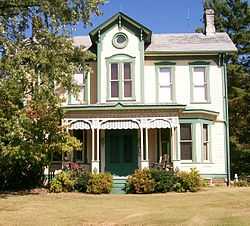Barnett-Criss House
|
Barnett-Criss House | |
 | |
|
The Barnett Criss House on Best Road outside of New Concord, Ohio | |
 | |
| Location | SW of Cambridge off U.S. 22, Cambridge, Ohio |
|---|---|
| Coordinates | 39°59′59″N 81°41′33″W / 39.99972°N 81.69250°WCoordinates: 39°59′59″N 81°41′33″W / 39.99972°N 81.69250°W |
| Area | 1 acre (0.40 ha) |
| Built | 1875 |
| Architect | Halstead,John & Charles |
| Architectural style | Italianate |
| Governing body | Private |
| NRHP Reference # | 78002070[1] |
| Added to NRHP | December 08, 1978 |
The Barnett-Criss House is an Italianate style house constructed on the much traveled National Road a few miles east of New Concord, Ohio. The house was placed on the National Register on 1978-12-08.
History
Oliver Barnett was a wealthy and prominent farmer from Westland Township in Guernsey County. He resided in the area for almost all his life, excepting a period of time in Pittsburgh, Pennsylvania after his service as an enlisted soldier in the Union Army.
Barnett moved back to the area in the mid-1870s and began construction on a showpiece home. He contracted the father-son team of John & Charles Halstead to build and design the house, as well as the interior wooden trim and several pieces of furniture. Construction lasted two years, from 1874 to 1876, and when finished was a fine example of the popular Italianate style of the Victorian era. The costs of construction amounted to a staggering sum of around $12,000.
Barnett did not enjoy the house for long, as the costs of construction and maintenance of his dream home drained his accounts which eventually led to him selling the house to Elijah Criss in 1890 for a paltry sum of $4450. Criss remained in the house to his death in 1921. The house remained in the Criss family until 1944, at which time it passed through several owners, each maintaining the quality of the unique home.
Exterior

The rectangular house sits on top of a sandstone basement with water table separating house from basement. The house facade is lined with wooden siding. The front of the house is accentuated by a front porch containing slender posts on broad bases. The posts are decorated with trusses reaching from each post to make an arch. The large front double-doors are capped by a transom window. The porch is framed to either side by a bay window.
The second floor is accentuated by a central tower with a decorative double window with a porthole window above it. The tower is capped by a gabled roof with decorative brackets and entablature. To either side of the tower are a pair of windows. The sloping roof is punctured to either end by a brick chimney.
The side of the house contained an open porch with a water pump. The porch was covered over into a sunroom sometime around 1900.
Interior
The main entrance at the front of the house opens up into the central hall with a staircase leading to the second floor bedrooms. To the left of the hall is the parlor which contains an original brass gas chandelier with springs and a pulley for easier maintenance. A fireplace with decorative carved wooden panels add a touch of sophistication.
The parlor once opened up onto another open porch with a necessary located nearby. The porch was covered over and was split into a study and a bathroom. This room opens up into the large kitchen. A large cooking fireplace graces the center of the outside wall with a food pantry to its right. This pantry is said to be designed by a specialist who could maintain a consistent cool temperature. The kitchen opens up onto the central hall or continues into the dining room or sunporch.
The dining room contains a fireplace much like the one in the parlor. The bay window at one end of the room was used as a tea area. The doors throughout the house are framed by oak frames with a frosted levered window. The doors are all hung on decorative iron hinges.
References
- ↑ "National Register Information System". National Register of Historic Places. National Park Service. 2009-03-13.
| |||||||||||||||||
| ||||||||||||||||||||
